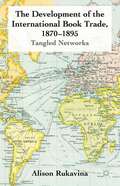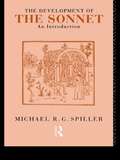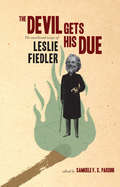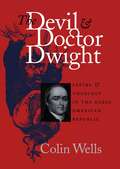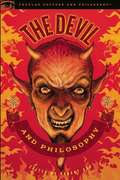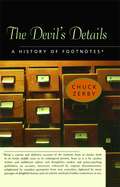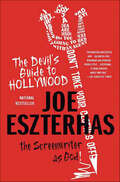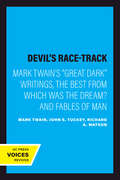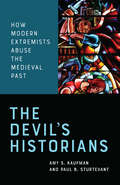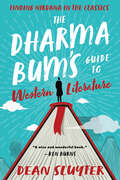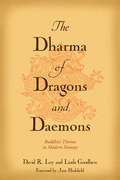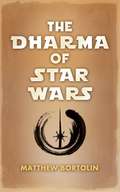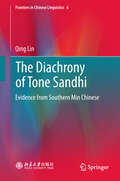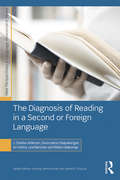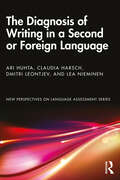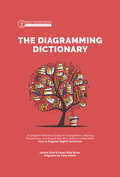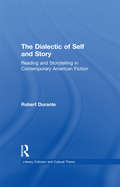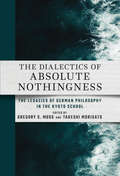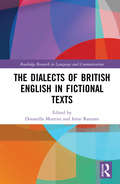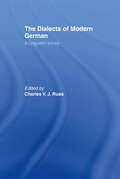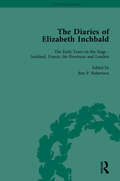- Table View
- List View
The Development of the International Book Trade, 1870–1895
by By Alison RukavinaAn international trade emerged between 1870-1895 that incorporated the circulation of books among countries worldwide. A history of the social network and select agents who sold and distributed books overseas, this study demonstrates agents increasingly thought of the world as a negotiable, connected system and books as transnational commodities.
The Development of the Sonnet: An Introduction
by Michael R. SpillerFirst published in 1992. Routledge is an imprint of Taylor & Francis, an informa company.
The Devil Gets His Due: The Uncollected Essays of Leslie Fiedler
by Leslie FiedlerDespite his often-unacknowledged influence, academics, intellectuals, and the general audience in America and abroad still read Leslie Fiedler’s work and draw on its concepts. He inspired both reverence (Leonard Cohen penned: "leaning over the American moonlight / like the shyest gargoyle / who will not become angry or old") and rage (Saul Bellow called him "the worst fucking thing that ever happened to American literature"). The essays in The Devil Gets His Due will reacquaint readers with the depth and breadth of Fiedler’s achievements. Tackling subjects ranging wildly from Dante, Ezra Pound, and Mary McCarthy to Rambo, Iwo Jima, and Jerry Lewis, these writings showcase Fiedler’s pioneering of an egalitarian canon that encompassed both "high" and popular literature, cinema, and history. As such, they show a powerful mind critiquing whole aspects of a culture and uncovering lessons therein that remain timely today. A lengthy introduction by Professor Samuele F. S. Pardini offers both context and history, with an in-depth profile of Fiedler and his career as both a literary critic and a public intellectual.
The Devil and Doctor Dwight
by Colin WellsAt the close of the eighteenth century, Timothy Dwight--poet, clergyman, and, later, president of Yale College--waged a literary and intellectual war against the forces of "infidelity." The Devil and Doctor Dwight reexamines this episode by focusing on The Triumph of Infidelity (1788), the verse satire that launched Dwight's campaign and, Colin Wells argues, the key to recovering the deeper meaning of the threat of infidelity in the early years of the American Republic. The book also features the first modern, annotated edition of this important but long-overlooked poem.Modeled after Alexander Pope's satiric masterpiece, the Dunciad, Dwight's poem took aim at a number of his contemporaries, but its principal target was Congregationalist Charles Chauncy, author of a controversial treatise asserting "the salvation of all men." To Dwight's mind, a belief in universal salvation issued from the same naive faith in innate human virtue and inevitable progress that governed all forms of Enlightenment thought, political as well as religious. Indeed, in subsequent works he traced with increasing dismay a shift in the idea of universal salvation from a theological doctrine to a political belief and symbol of American national identity. In this light, Dwight's campaign against infidelity must also be seen as an early and prescient critique of the ideological underpinnings of Jeffersonian democracy.
The Devil and Philosophy
by Robert ArpIn The Devil and Philosophy, 34 philosophers explore questions about one of the most recognizable and influential characters (villains?) of all time. From Roman Polanski's The Ninth Gate to J.R.R. Tolkien's The Silmarillion to Bram Stoker's Dracula to Darth Vader to Al Pacino's iconic performance in The Devil's Advocate, this book demonstrates that a little devil goes a long way. From humorous appearances, as in Kevin Smith's film Dogma and Chuck Palahniuk's novels Damned and its sequel Doomed, to more villanous appearances, such as Gabriel Byrne's cold outing as Satan in End of Days, The Devil in Philosophy proves that the Devil comes in many forms.Through the lenses of Jung, Kant, Kundera, Balkan, Plato, Bradwardine, Aristotle, Hume, Blackburn, Descartes, Lavey, Thoreau, and Aquinas, The Devil and Philosophy take a philosophical look at one of time's greatest characters. Are there any good arguments for the actual existence of the Devil? Does demonic evil thrive in Gotham City? Can humans really be accountable for all evil? Which truths about the Devil are actual facts? Is Milton correct, in that the Devil believes he is doing good?
The Devil and the Vice in the English Dramatic Literature Before Shakespeare (Routledge Revivals)
by L. W. CushmanOriginally published in 1900, this book was the first investigation of the devil and the Vice as dramatic figures, and a study of these figures led to a new view of the subject: it is, in brief, that the appearance of the devil in the non-dramatic as well as in the dramatic literature is limited to a definite range. As a dramatic figure the devil falls more and more into the background and the Vice is distinct in origin and function from the devil.
The Devil's Details
by Chuck ZerbyFootnotes have not had it easy. Their dominance of eighteenth- and nineteenth- century literature and scholarship was both hard-won -- following many years of struggle -- and doomed, as it led to belittlement in the twentieth century. InThe Devil's Details,Chuck Zerby playfully explores footnotes' long and illustrious history and makes a clarion call to save them from the new world of the Internet and hypertext. In a story that boasts a marvelous plot and a rogues' gallery of players, Zerby examines traditional footnotes and their less-buttoned-down incarnations, as when used by pornographers. Yes,The Devil's Detailsis full of surprises: Zerby hunts down the first bona fide fully functioning footnote; unearths a multivolume history of Northumberland County, England, that uses one volume for a single footnote; and uncovers a murder plot. He even explains why footnotes are like blind dates. Carefully researched and highly opinionated,The Devil's Detailsaffirms that delight in reading can come from unexpected places.
The Devil's Guide to Hollywood: The Screenwriter as God!
by Joe EszterhasIn The Devil's Guide to Hollywood, bestselling author and legendary bad-boy screenwriter Joe Eszterhas tells everything he knows about the industry, its players and screenwriting itself—from the first blank sheet of paper in the Olivetti to the size of the credit on the one-sheet. "There's just one hunk of funny anecdote after another, quotes from everyone who ever mattered in the movie biz, and the thing is jam-packed with screenwriterly advice. Plus it's hilariously funny, ribald, sexy and brilliant."—Liz SmithOften practical and always entertaining, The Devil's Guide to Hollywood distills everything one of Hollywood's most accomplished screenwriters knows about the business, from writing advice to negotiation tricks, from the wisdom of past players to the feuds of current ones. Eszterhas has selected his personal pantheon of the most loved and loathed players in the business and treats the reader to a treasure trove of stories, quotes and wisdom from those luminaries, who include William Goldman (loathes) and Zsa Zsa Gabor (loves). The Devil's Guide to Hollywood could only have been written by someone who loves the business as much as Eszterhas does—but who also has its number."Eszterhas delivers a dishy, catty mix of reminiscences and Hollywood trivia…his forte is skewering sycophants and phonies in this opinionated showcase of the underside of Hollywood life."—Publishers Weekly
The Devil's Race-Track: Mark Twain's "Great Dark" Writings, The Best from Which Was the Dream? and Fables of Man
by Mark TwainMark Twain explores the darker side of life in these lesser-known later writings dealing with personal tragedies, nightmarish world events, and a doubtful cosmic order. He views his own situation as that of a ship trapped in a fearsome Bermuda Triangle-like region, the Devil's Race-Track. He sees history as a treadmill of endlessly and monotonously repeated events. And he conceives of a universal food chain, a vast round of devourers who in their turn become victims, humankind and God included. The tone of these writings is lightened considerably by Mark Twain's sagely ironic humor and his warmth, which together balance his tough-mindedness. And even when he shows the human race caught in some vicious circle, he may be seen courageously seeking a way out and at times believing he has found it.
The Devils and Canon Barham: Ten Essays on Poets, Novelists and Monsters
by Leon Edel Edmund WilsonThe book takes its title from the scene of Lenin's arrival from Germany in April 1917, ready to take over the leadership of the Russian Revolution and in doing so bring to a climax the political and intellectual movements which are the subject of this study.
The Devil’s Historians: How Modern Extremists Abuse the Medieval Past
by Amy Kaufman Paul SturtevantAmy S. Kaufman and Paul B. Sturtevant examine the many ways in which the medieval past has been manipulated to promote discrimination, oppression, and murder. Tracing the fetish for “medieval times” behind toxic ideologies like nationalism, antisemitism, Islamophobia, misogyny, and white supremacy, Kaufman and Sturtevant show us how the Middle Ages have been twisted for political purposes in every century that followed. The Devil’s Historians casts aside the myth of an oppressive, patriarchal medieval monoculture and reveals a medieval world not often shown in popular culture: one that is diverse, thriving, courageous, compelling, and complex.
The Dharma Bum’s Guide to Western Literature: Finding Nirvana in the Classics
by Dean SluyterHOW THE LITERATURE WE LOVE CONVEYS THE AWAKENING WE SEEK Suppose we could read Hemingway as haiku . . . learn mindfulness from Virginia Woolf and liberation from Frederick Douglass . . . see Dickinson and Whitman as buddhas of poetry, and Huck Finn and Gatsby as seekers of the infinite . . . discover enlightenment teachings in Macbeth, The Catcher in the Rye, Moby-Dick, and The Bluest Eye. Some of us were lucky enough to have one passionate, funny, inspiring English teacher who helped us fall in love with books. Add a lifetime of teaching Dharma — authentic, traditional approaches to meditation and awakening — and you get award-winning author Dean Sluyter. With droll humor and irreverent wisdom, he unpacks the Dharma of more than twenty major writers, from William Blake to Dr. Seuss, inspiring readers to deepen their own spiritual life and see literature in a fresh, new way: as a path of awakening.
The Dharma of Dragons and Daemons: Buddhist Themes in Modern Fantasy
by David R. Loy Linda Goodhew Jane HirshfieldIn order to live, we need air, water, food, shelter...and stories. This book is about Buddhist stories: not about stories to be found in Buddhism, but about the "Buddhism" to be found in some of the classics of contemporary fantasy including the works of J. R. R. Tolkien, Hayao Miyazaki, Michael Ende, Philip Pullman, and Ursula K. LeGuin.Many books are called groundbreaking, but this one is truly unique and sure to appeal to anyone with an interest in fantasy literature. It employs a Buddhist perspective to appreciate some of the major works of modern fantasy--and uses modern fantasy fiction to elucidate Buddhist teachings. In the tradition of David Loy's cutting-edge presentation of a Buddhist social theory in The Great Awakening, this pioneering work of Buddhist literary analysis, renown scholar David Loy and Linda Goodhew offer ways of reading modern fantasy-genre fiction that illuminate both the stories themselves, and the universal qualities of Buddhist teachings. Authors examined include J.R.R. Tolkien, Philip Pullman (of The Amber Spyglass trilogy, from whose works the word "daemon" is borrowed in the title), Ursula K. LeGuin, and the anime movie Princess Mononoke.
The Dharma of Star Wars
by Matthew BortolinPlumbing the Star Wars universe for spiritual lessons is as old as the first Star Wars film released in 1977. The author of this book looks through a specifically Buddhist lens, using Buddhist philosophy to interpret the characters, plots, and dialogue.
The Diachrony of Tone Sandhi: Evidence from Southern Min Chinese (Frontiers in Chinese Linguistics #6)
by Qing LinThis book investigates the diachronic change of the tone sandhi of Southern Min Chinese, which is known for its synchronic arbitrariness and opacity. It argues that in final-prominent tone sandhi, the change of final tones and the change of non-final tones can be highly independent and essentially different from each other. Accordingly, it proposes a new position-based diachronic approach to study the separate evolution of tones occurring at different positions. This book is the first study to rigorously and systematically explore the diachrony of Southern Min tone sandhi.
The Diachrony of Verb Meaning: Aspect and Argument Structure (Routledge Studies in Historical Linguistics)
by Elly van GelderenThis innovative volume offers a comprehensive account of the study of language change in verb meaning in the history of the English language. Integrating both the author’s previous body of work and new research, the book explores the complex dynamic between linguistic structures, morphosyntactic and semantics, and the conceptual domain of meaning, employing a consistent theoretical treatment for analyzing different classes of predicates. Building on this analysis, each chapter connects the implications of these findings from diachronic change with data from language acquisition, offering a unique perspective on the faculty of language and the cognitive system. In bringing together a unique combination of theoretical approaches to provide an in-depth analysis of the history of diachronic change in verb meaning, this book is a key resource to researchers in historical linguistics, theoretical linguistics, psycholinguistics, language acquisition, and the history of English.
The Diagnosis of Reading in a Second or Foreign Language (New Perspectives on Language Assessment Series)
by J. Charles Alderson Eeva-Leena Haapakangas Ari Huhta Lea Nieminen Riikka UllakonojaThe Diagnosis of Reading in a Second or Foreign Language explores the implications of language assessment research on classroom-based assessment practices by providing an in-depth look at the little-examined field of diagnosis in second and foreign language reading. This volume examines the development of second and foreign language reading and how subsequent research findings, couched in this knowledge, can help facilitate a more-informed teaching approach in second and foreign language classrooms. By contextualizing the latest in classroom settings and presenting implications for future research in this developing area of linguistics, this book is an ideal resource for those studying and working in applied linguistics, second language acquisition, and language assessment and education. About the NPLA Series: Headed by two of its leading scholars, the series captures the burgeoning field of language assessment by offering comprehensive and state-of-the-art coverage of its contemporary questions, pressing issues, and technical advances. It is the only active series of its kind on the market, and will include volumes on basic and advanced topics in language assessment, public policy and language assessment, and the interfaces of language assessment with other disciplines in applied linguistics. Each text presents key theoretical approaches and research findings, along with concrete practical implications and suggestions for readers conducting their own research or developmental studies.
The Diagnosis of Writing in a Second or Foreign Language (New Perspectives on Language Assessment Series)
by Ari Huhta Lea Nieminen Dmitri Leontjev Claudia HarschThe Diagnosis of Writing in a Second or Foreign Language is a comprehensive survey of diagnostic assessment of second/foreign language (SFL) writing. In this innovative book, a compelling case is made for SFL writing as an individual, contextual, and multidimensional ability, combining several theoretically informed approaches upon which to base diagnosis. Using the diagnostic cycle as the overarching framework, the book starts with the planning phase, cover design, development, and delivery of diagnostic assessment, ending with feedback and feed-forward aspects to feed diagnostic information into the teaching and learning process. It covers means to diagnose both the writing processes and products, including the design and development of diagnostic tasks and rating scales, as well as automated approaches to assessment. Also included is a range of existing instruments and approaches to diagnosing SFL writing. Addressing large-scale as well as classroom contexts, this volume is useful for researchers, teachers, and educational policy-makers in language learning.
The Diagramming Dictionary: A Complete Reference Tool For Young Writers, Aspiring Rhetoricians, And Anyone Else Who Needs To Understand How English Works (Grammar for the Well-Trained Mind #0)
by Susan Wise Bauer Jessica OttoOn its own or as a supplement to the Grammar for the Well-Trained Mind program, this complete compendium of sentence diagramming rules, complete with illustrated sample diagrams, will become an indispensable guide to diagramming and writing—throughout high school, into college, and beyond. Do you understand what makes good writing "good"? Are you struggling against your words instead of using them to express yourself well? Diagramming a sentence shows you how it is (or isn't) working, and unlocks the door to clear, balanced writing. This handbook from Susan Wise Bauer, author of Grammar for the Well-Trained Mind, walks students through the rules of diagramming, from the simplest sentences to the most complex. Its simple instructions allow you to learn at your own pace, without an instructor. Full of easy-to-understand example diagrams, color-coded for quick recognition, this guide will be a trusted reference tool in your home, office, or school for years to come. For ages 13 and Up.
The Dialectic of Self and Story: Reading and Storytelling in Contemporary American Fiction (Literary Criticism and Cultural Theory)
by Robert DuranteFirst Published in 2001. Routledge is an imprint of Taylor & Francis, an informa company.
The Dialectics of Absolute Nothingness: The Legacies of German Philosophy in the Kyoto School
by Gregory S. Moss Takeshi MorisatoThe Dialectics of Absolute Nothingness investigates the appropriations, critiques, and innovative interpretations of German philosophy by the Kyoto School, showing how central concepts of German philosophical traditions found a place within non-Western frameworks such as Zen and Pure Land Buddhism, thereby transcending the original Western context.Kyoto School philosophers critically engaged with their own tradition and grappled with classical German philosophy from Kant to German Idealism and from Neo-Kantianism to German phenomenology. Far from mimicking the Western tradition, Nishida, Tanabe, Nishitani and other Japanese philosophers overcame their sense of alienation from European philosophy by making its concepts their own and advancing their ideas as a hybrid of European and Japanese philosophy through which they developed their own world historical perspective.Showcasing the ways that Kyoto School philosophers internalized German philosophy and generated their own original perspectives, The Dialectics of Absolute Nothingness demonstrates the Kyoto School's potential for culturally diversifying the study of German philosophy and paves the way for the comprehensive study of Asian philosophy in European and global contexts.
The Dialects of British English in Fictional Texts (Routledge Research in Language and Communication)
by Donatella Montini Irene RanzatoThis collection brings together perspectives on regional and social varieties of British English in fictional dialogue across works spanning various literary genres, showcasing authorial and translation innovation while also reflecting on their impact on the representation of sociolinguistic polarities. The volume explores the ways in which different varieties of British English, including Welsh, Scots, and Received Pronunciation, are portrayed across a range of texts, including novels, films, newspapers, television series, and plays. Building on metadiscourse which highlighted the growing importance of accent as an emblem of social stance in the eighteenth and nineteenth centuries, the chapters in this book examine how popular textual forms create and reinforce links between accent and social persona, and accent and individual idiolect. A look at these themes, as explored through the lens of audiovisual translation and the challenges of dubbing, sheds further light on the creative resources authors and translators draw on in representing sociolinguistic realities through accent. This book will be of particular interest to students and scholars in dialectology, audiovisual translation, literary translation, and media studies.
The Dialects of Italy
by Martin Maiden Mair ParryThis book makes accessible the major structural features of the dialects of Italy and emphasises the importance of a detailed understanding of the dialects for issues in general linguistic theory. Selected contents include: * Phonology * Morphology * Syntax * Lexis * The Dialect Areas * Sociolinguistics of Dialects Contributors: Paola Benica; Gaetano Berruto; Guglielmo Cinque; Michela Cennamo; Patrizia Cordin; Thamas Cravens; Marie-Jose Dalbera Stefanaggi; Franco Fanciullo; Werner Forner; Luciano Giannelli; John Hajek; Hermann Haller; Robert Hastings; Michael Jones; Michele Loporcaro; Martin Maiden; Marco Mazzoleni; Zarko Miljacic; Mair Parry; Cecilia Poletto; Lorenzo Renzi; Lori Repetti; Giovanni Ruffino; Giampaolo Salvi; Glauco Sanga; Leonardo Savoia; Alberto Sobrero; Rosanna Sornicola; Tullio Telmon; John Trumper; Edward Tuttle; Alberto Valvaro; Laura Vanelli; Ugo Vignuzzi; Nigel Vincent; Irene Vogel.
The Dialects of Modern German: A Linguistic Survey
by Charles V. J. RussThis unique reference volume covers the 18 dialects of Germany, Austria, Switzerland, Alsace and Luxembourg. Each section discusses the status of dialect in the region concerned together with the historical and geographical background. Then follows a description of the dialect structure of the region, copiously illustrated with phonological, grammatical and lexical examples in IPA transcription. The phonology, grammar and vocabulary of one typical dialect are presented together with a commentary. All examples are given with English glosses. The volume will be of most interest to Germanists with some knowledge of the linguistics and history of German, wishing to deepen their knowledge of German dialects. General linguists and sociolinguists who wish to know about German dialects will also find it useful. It can serve as an intermediate level textbook for any course on German dialects which builds on a linguistics or history of German course.
The Diaries of Elizabeth Inchbald Vol 1
by Ben P RobertsonAn energetic woman, Inchbald achieved fame as an actress, novelist, playwright and critic. This work includes her eleven surviving diaries, which record Inchbald's social contacts and professional activities, itemize her day-to-day expenditure, and chart the development of affairs such as the Napoleonic Wars and the trial of Queen Caroline.
